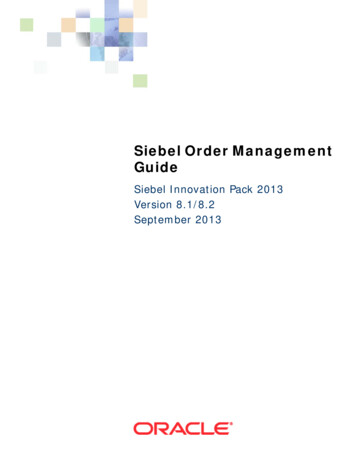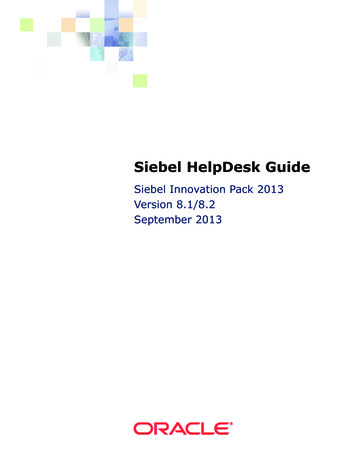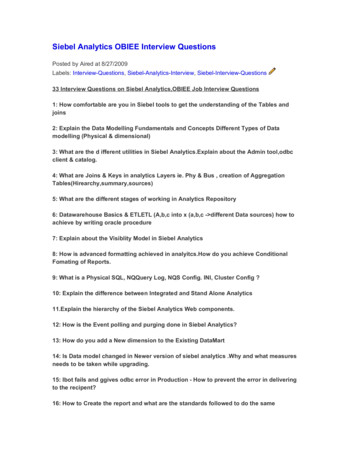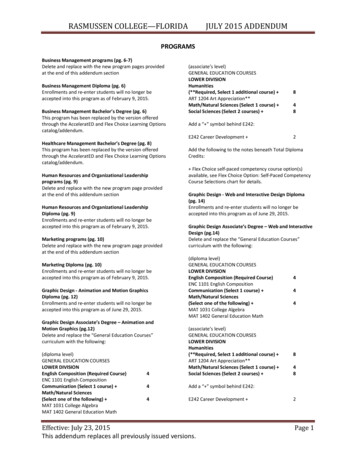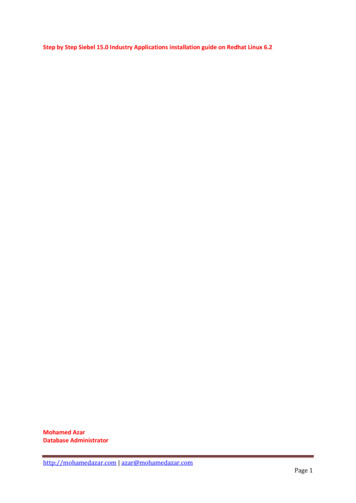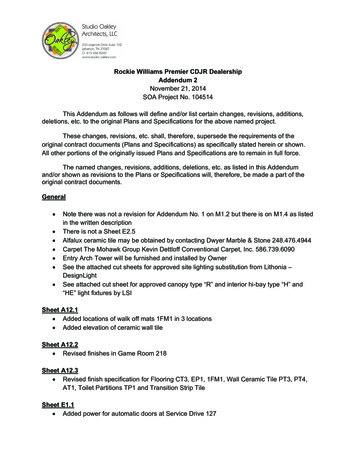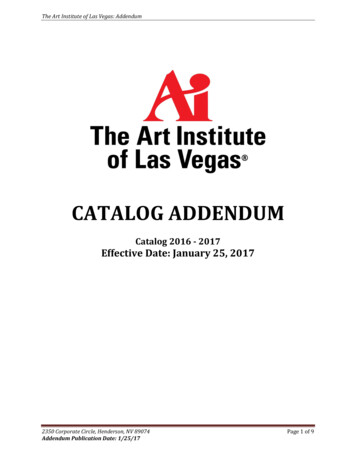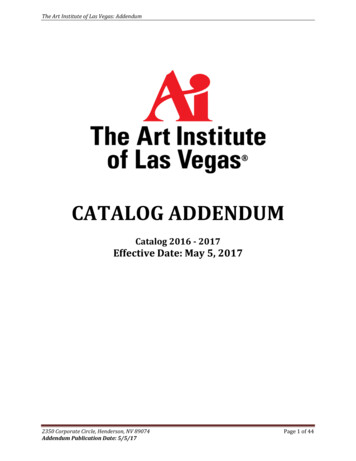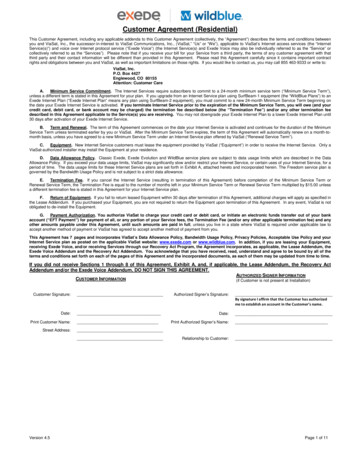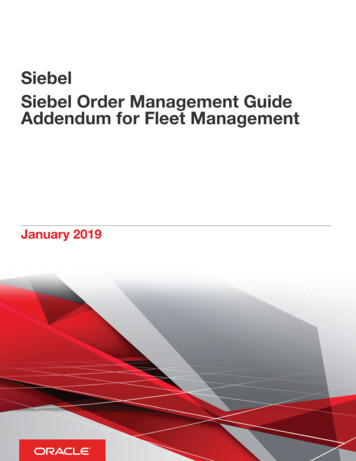
Transcription
SiebelSiebel Order Management GuideAddendum for Fleet ManagementJanuary 2019
SiebelSiebel Order Management Guide Addendum for Fleet ManagementJanuary 2019Part Number: F12764-01Copyright 2019, Oracle and/or its affiliates. All rights reservedAuthors: Siebel Information Development TeamThis software and related documentation are provided under a license agreement containing restrictions on use and disclosure and are protected byintellectual property laws. Except as expressly permitted in your license agreement or allowed by law, you may not use, copy, reproduce, translate, broadcast,modify, license, transmit, distribute, exhibit, perform, publish, or display in any part, in any form, or by any means. Reverse engineering, disassembly, ordecompilation of this software, unless required by law for interoperability, is prohibited.The information contained herein is subject to change without notice and is not warranted to be error-free. If you find any errors, please report them tous in writing.If this is software or related documentation that is delivered to the U.S. Government or anyone licensing it on behalf of the U.S. Government, the followingnotice is applicable:U.S. GOVERNMENT END USERS: Oracle programs, including any operating system, integrated software, any programs installed on the hardware, and/or documentation, delivered to U.S. Government end users are "commercial computer software" pursuant to the applicable Federal Acquisition Regulationand agency-specific supplemental regulations. As such, use, duplication, disclosure, modification, and adaptation of the programs, including any operatingsystem, integrated software, any programs installed on the hardware, and/or documentation, shall be subject to license terms and license restrictionsapplicable to the programs. No other rights are granted to the U.S. Government.This software or hardware is developed for general use in a variety of information management applications. It is not developed or intended for use inany inherently dangerous applications, including applications that may create a risk of personal injury. If you use this software or hardware in dangerousapplications, then you shall be responsible to take all appropriate fail-safe, backup, redundancy, and other measures to ensure its safe use. OracleCorporation and its affiliates disclaim any liability for any damages caused by use of this software or hardware in dangerous applications.Oracle and Java are registered trademarks of Oracle Corporation and/or its affiliates. Other names may be trademarks of their respective owners.Intel and Intel Xeon are trademarks or registered trademarks of Intel Corporation. All SPARC trademarks are used under license and are trademarks orregistered trademarks of SPARC International, Inc. AMD, Opteron, the AMD logo, and the AMD Opteron logo are trademarks or registered trademarks ofAdvanced Micro Devices. UNIX is a registered trademark of The Open Group.This software or hardware and documentation may provide access to or information about content, products, and services from third parties. OracleCorporation and its affiliates are not responsible for and expressly disclaim all warranties of any kind with respect to third-party content, products, andservices unless otherwise set forth in an applicable agreement between you and Oracle. Oracle Corporation and its affiliates will not be responsible for anyloss, costs, or damages incurred due to your access to or use of third-party content, products, or services, except as set forth in an applicable agreementbetween you and Oracle.The business names used in this documentation are fictitious, and are not intended to identify any real companies currently or previously in existence.
SiebelSiebel Order Management Guide Addendum for FleetManagementContentsPreface . i1What’s New in This Release1What’s New in Siebel Order Management Guide Addendum for Fleet Management, Siebel CRM 19.1 Update . 1What’s New in Siebel Order Management Guide Addendum for Fleet Management, Siebel 2018 . 12Overview of Siebel Orders for Fleet Management3Overview of Siebel Orders for Fleet Management . 3Oracle Fleet Management . 3About Siebel Orders for Fleet Management . 4Scenario for Using Siebel Orders for Fleet Management . 43Administering Siebel Orders for Fleet Management7Administering Siebel Orders for Fleet Management . 7About Administering Upselling for Fleet Management . 7Creating Products for Fleet Management . 9Creating Locations for Fleet Management . 10Creating Product Favorites for Fleet Management . 13Configuring Picklists for Fleet Management . 15Configuring Validation for Verifying and Submitting Orders for Fleet Management . 21Configuring Validation for Canceling Orders for Fleet Management . 224Using Siebel Orders for Fleet Management25Using Siebel Orders for Fleet Management . 25About Adding Accessorial Products to Orders . 25About Spot Quoting . 25Process of Creating Orders for Fleet Management . 26About Working with Existing Fleet Management Orders . 40
SiebelSiebel Order Management Guide Addendum for FleetManagement
SiebelSiebel Order Management Guide Addendum for FleetManagementPrefacePrefaceThis preface introduces information sources that can help you use the application and this guide.Using Oracle ApplicationsTo find guides for Oracle Applications, go to the Oracle Help Center at http://docs.oracle.com/.Documentation AccessibilityFor information about Oracle's commitment to accessibility, visit the Oracle Accessibility Program website.Contacting OracleAccess to Oracle SupportOracle customers that have purchased support have access to electronic support through My Oracle Support. Forinformation, visit My Oracle Support or visit Accessible Oracle Support if you are hearing impaired.Comments and SuggestionsPlease give us feedback about Oracle Applications Help and guides! You can send an e-mail to:oracle fusion applications help ww grp@oracle.com.i
SiebelSiebel Order Management Guide Addendum for FleetManagementPrefaceii
SiebelSiebel Order Management Guide Addendum for FleetManagement1Chapter 1What’s New in This ReleaseWhat’s New in This ReleaseWhat’s New in Siebel Order Management GuideAddendum for Fleet Management, Siebel CRM 19.1UpdateNo new features have been added to this guide for this release. This guide has been updated to reflect only product namechanges.Note: Siebel 2019 is a continuation of the Siebel 8.1/8.2 release.What’s New in Siebel Order Management GuideAddendum for Fleet Management, Siebel 2018No new features have been added to this guide for this release. This guide has been updated to reflect only product namechanges.Note: Siebel 2018 is a continuation of the Siebel 8.1/8.2 release.1
SiebelSiebel Order Management Guide Addendum for FleetManagementChapter 1What’s New in This Release2
SiebelSiebel Order Management Guide Addendum for FleetManagementChapter 2Overview of Siebel Orders for Fleet Management2Overview of Siebel Orders for FleetManagementOverview of Siebel Orders for Fleet ManagementThis chapter provides an overview of Siebel Orders for Fleet Management. It includes the following topics: Oracle Fleet Management About Siebel Orders for Fleet Management Scenario for Using Siebel Orders for Fleet ManagementOracle Fleet ManagementOracle Fleet Management is used to manage a fleet that provides transportation services, such as a fleet of tractors, trailers,and their drivers. It is used to: Manage the individual assets. Plan the use of the fleet of assets. Take orders for the use of the assets Dispatch the assets. Monitor and track the assets in real time. Settle the costs associated with the fleet. Manage human resources (drivers) for the fleet. Manage the life cycle of the assets.Oracle Fleet Management involves integration of the following applications: Siebel Customer Relationship Management (CRM). Order capture Oracle Transportation Management. Fleet planning and execution, and driver management Enterprise Business Suite Asset Lifecycle Management. Asset definition, management and maintenance Enterprise Business Suite Human Resources. Driver human resources, such as scheduling and pay Enterprise Business Suite Financials. Settlement, accruals, and financial management Application Integration Architecture. Integration using Process Integration PacksNote: It is possible to integrate with other applications instead of with these Oracle applications. For example,you might have a legacy, transportation-management application that you integrate with instead of OracleTransportation Management. If you have integrated with another transportation-management application,whenever this document mentions Oracle Transportation Management, use this other application instead.3
SiebelSiebel Order Management Guide Addendum for FleetManagementChapter 2Overview of Siebel Orders for Fleet ManagementAbout Siebel Orders for Fleet ManagementThis book covers only using Siebel CRM for capturing orders within Oracle Fleet Management. Use this book with SiebelOrder Management Guide . This book describes the features of Siebel Orders for Fleet Management that are different fromthe standard features of Siebel Order Management.The following standard features of Siebel Order Management do not apply to Siebel Orders for Fleet Management: Pricing. Any discussion of pricing in Siebel Order Management Guide and Siebel Pricing Administration Guidedoes not explicitly apply to Siebel Orders for Fleet Management, which uses the rating inquiry engine of OracleTransportation Management to do its pricing. Quotes. Siebel Orders for Fleet Management supports spot quoting, as described in About Spot Quoting. Thediscussion of other forms of quoting in Siebel Order Management Guide does not apply to Siebel Orders for FleetManagement. Upsell Products. The discussion of upsell products in Siebel Product Administration Guide does not explicitlyapply to Siebel Orders for Fleet Management, which has its own method of creating upsell products, described inAbout Administering Upselling for Fleet Management. Eligibility. Eligibility to purchase products, as described in Siebel Order Management Guide and Siebel ProductAdministration Guide , does not apply to fleet management, and the fields related to eligibility are removed fromOrder and Product records.Note: The Siebel Bookshelf is available on Oracle Technology Network (OTN) and Oracle E-Delivery. It mightalso be installed locally on your intranet or on a network location.Oracle Fleet Management requires the integration of the Siebel application with the other applications listed previously inOracle Fleet Management. This integration uses the Web services covered in Siebel CRM Web Services ReferenceScenario for Using Siebel Orders for Fleet ManagementThis topic gives one example of how Siebel Orders for Fleet Management might be used. You might use it differently,depending on your business model.Taking the OrderA customer service representative at a delivery company gets a call from a customer who wants to schedule a one-waydelivery of fragile materials.The customer service representative looks up the customer in the Siebel application. If the customer is an existing customer,the customer service representative uses the customer information already in the database. If the customer is a newcustomer, the customer service representative adds the account and contacts in the Siebel application in the usual way, asdescribed in Siebel Applications Administration Guide .The customer service representative creates a new order, entering information in the order header and order line item forSiebel Orders for Fleet Management, as described in Process of Creating Orders for Fleet Management. The order contains4
SiebelChapter 2Siebel Order Management Guide Addendum for FleetOverview of Siebel Orders for Fleet ManagementManagementadded fields that are specific to fleet management. For example, the header includes the origin and destination locations forthis delivery. This information will be passed to back-office applications and used to price and manage the order.In the Line Items view, the customer service representative adds a line item for the product named Transportation. In addition,because this is an order to transport fragile material, the customer service representative adds a line item for the accessorialproduct Driver Hand Unload By Piece, which means that the routine precautions for dealing with fragile materials will be takenand will be included in the price charged to the customer.The customer service representative enters the stop records for the transportation product. Because this order is a one-waydelivery, it has only two stops, the origin where the material is picked up, and the destination where it is delivered.The customer service representative also enters actions that are necessary at each of these stops. In this case, the actionsare special instructions that are needed while picking up and delivering fragile products.In the Commodity view, the customer service representative adds records specifying the commodity that will be delivered.The customer service representative enters the weight of the product and other relevant details. The customer servicerepresentative enters the stops and actions for the commodity.Rating the OrderNow that the details of the order have been entered, the customer service representative clicks the Get Rating & Routesbutton to rate the order. Siebel Orders for Fleet Management calls the rating engine of Oracle Transportation Management todo the rating.The rating engine determines the availability of resources to perform the delivery, based on the requested start date and therequested end date for the origin and destination. The rating engine also determines prices, including the total price, the baseprice for the delivery on each date, the price for the special handling, and other possible pricing details, such as a surchargefor fuel. It returns this information to the Siebel application, where it is displayed in the Solutions view.Completing and Verifying the OrderThe customer service representative uses the Siebel application to complete the order. The customer service representativetells the customer about the list of solutions that has been generated. Different solutions have different dates of delivery anddifferent prices. When the customer chooses a solution, the customer service representative selects the solution record andclicks Confirm Now.Information about this solution is added to the additional fields in the order record. These fields are used to capture pricingand resource information from Oracle Transportation Management.Upselling to the CustomerAfter entering all the information for this order, the customer service representative looks at the Upsell view.This view shows that, during the last six weeks, the customer has placed a large number of orders for rail transportation fromChicago to New York and that these orders had a large static profit. It also shows that rail transportation from Chicago toNew York is a targeted lane, which the transportation company is focusing on selling.5
SiebelSiebel Order Management Guide Addendum for FleetManagementChapter 2Overview of Siebel Orders for Fleet ManagementThe customer service representative asks whether the customer will want rail transportation from Chicago to New York in thenear future. The customer will want it later in the week and will want to check the pricing, and possibly place the order now.After submitting the current order, the customer service representative clicks the Auto-Order button to create the newupsell order. The customer service representative will then get more details for the new order from the customer, and willgenerate possible solutions for the customer. The customer service representative asks whether the customer will also wanttransportation in some of the other lanes in the Upsell list, but the customer does not want this immediately.Submitting the Order and Checking the StatusThe current order is complete, so the customer service representative clicks the Submit button. After the order is submitted,the information is passed from the Siebel application to Oracle Transportation Management, which executes the order andreturns information on the order’s status to the Siebel application.If the customer inquires about the status of the order, the customer service representative can respond by looking at theStatus field of the order record, line item records, stop records, and action records in the Siebel application.6
SiebelSiebel Order Management Guide Addendum for FleetManagementChapter 3Administering Siebel Orders for Fleet Management3Administering Siebel Orders for FleetManagementAdministering Siebel Orders for Fleet ManagementThis chapter covers the administrative tasks for Siebel Orders for Fleet Management that are different from the standardadministrative tasks for order management. It includes the following topics: About Administering Upselling for Fleet Management Creating Products for Fleet Management Creating Locations for Fleet Management Creating Product Favorites for Fleet Management Configuring Picklists for Fleet Management Configuring Validation for Verifying and Submitting Orders for Fleet Management Configuring Validation for Canceling Orders for Fleet ManagementAbout Administering Upselling for Fleet ManagementAfter customer service representatives have entered orders, they go to the Upsell view to see which lanes they will try toupsell to a customer. The records displayed in the Upsell view depend on: Score. A score is calculated for each lane for this customer, based on the customer’s order history; see Configuringthe Score for Upselling. It displays the ten lanes with the highest scores in the Upsell view. The customer is mostlikely to ship product using these lanes, and they have the highest profit. Targeted lanes. Your marketing department creates a list of targeted lanes, which are routes where your companywants to focus on selling transportation. If a lane displayed in the Upsell view is also a targeted lane, it is indicated inthe NM (network management) field for that lane.The customer service representative can upsell to this customer in these ten lanes and can emphasize the lanes that aretargeted lanes, as described in Upselling to the Customer. If the customer places an upsell order, it is an additional order,which is separate from the initial order.For more information about administering upselling, see: Configuring the Score for Upselling Adding Targeted LanesConfiguring the Score for UpsellingWhenever Oracle Transportation Management sends information that an order is complete, the Siebel application addsinformation about this order to its order history. The order history aggregates weekly orders for each account for each lane.This history is used to calculate a score for each lane that each account uses.7
SiebelSiebel Order Management Guide Addendum for FleetManagementChapter 3Administering Siebel Orders for Fleet ManagementWith the preconfigured Siebel Orders for Fleet Management application, the score is calculated for the last six weeks. Thisperiod is configurable and is stored in the system preference, FM Eval Period in Weeks.The score is configurable. It is a calculation with a weighted measure, including loads for each week and static profit for allorders that a customer has placed for a lane during the evaluation period.Formula for Calculating the ScoreYou can configure the score by changing the system preferences used in the formula for calculating the score.With the preconfigured application, the score for each lane for each account is calculated using the following formula:Min(FM Upsell Score Max Ord Count, Order Count)*Min(FM Upsell Score Max Stat Prft,Order Static Profit).The formula uses the following variables, some of which are configurable: Order Count. The total number of orders from this account for this lane during a given period. The period is definedby system preference: FM Eval Period in Weeks, as mentioned previously, and it can be configured by changing thevalue of this system preference. The Order Count field itself must be part of the formula and cannot be removed orreplaced with another field. The Order Count field is in the FM Order History business component. FM Upsell Score Max Ord Count. A system preference that indicates the maximum value for the number of ordersused in the calculation. The default value is 6. You can configure the variable by changing the value of the systempreference. Order Static Profit. The total static profit from this account for this lane. You cannot configure this variable. The OrderStatic Profit field is in the FM Order History business component. FM Upsell Score Max Stat Prft. A system preference that indicates the maximum value for the static profit used in thecalculation. The default value is 500. You can configure the variable by changing the value of the system preference.For more information about setting system preferences, see Siebel Applications Administration Guide .How the Score Is UsedAfter a customer service representative creates an order for a customer, the lanes with the highest score for that customerare displayed in the Upsell view for the order. The records are sorted by score, so that the lane with the highest score is at thetop of the list. With the preconfigured application, the ten highest lanes are listed. This value is configurable and is stored insystem preference FM No of Upsell Lanes.The customer service representative tries to sell the customer more orders for these lanes in addition to the initial order,because these are the lanes where the customer is likely to place orders with a high static profit.Adding Targeted LanesThe marketing department of the transportation provider defines the targeted lanes; that is, the lanes where the companywants to focus on selling transportation.A lane is a route between an origin and a destination using a given line of business. For example: Truck transportation from Chicago to New York is a lane. Rail transportation from Chicago to New York is a different lane.Instead of cities, regions can be used as the origin and destinations of lanes. For example, if a transportation provider targetsthe lane representing truck deliveries from Berlin to Paris, it might also want this lane to include deliveries from the suburbs of8
SiebelChapter 3Siebel Order Management Guide Addendum for FleetAdministering Siebel Orders for Fleet ManagementManagementBerlin and to the suburbs of Paris . To include the suburbs, it defines the regions, based on the postal codes, or on city andstate names. Regions are defined in external applications, which must be integrated with the Siebel application.You can define targeted lanes in an external application that is integrated with the Siebel application, or you can definetargeted lanes in the Siebel application, as described in the following procedure.To define targeted lanes1. Navigate to the Administration - Fleet Management screen, then the Targeted Lanes view.2. Display all fields:a. From the Targeted Lanes menu, select Columns Displayed.b. Use the Columns Displayed dialog box to move the Effective Start Date, Effective End Date, and Active fieldsfrom the Available Columns list to the Selected Columns list.c. Click Save.3. Add new records to the Targeted Lanes list, and complete the necessary fields, described in the following table.FieldDescriptionOrigin City, Origin StateIf you are using a city as the origin, enter the name of the city and state.Destination City, Destination StateIf you are using a city as the destination, enter the name of the city and state.Origin Pricing RegionIf you are using a region as the origin, enter the name of the region.Destination Pricing RegionIf you are using a region as the destination, enter the name of the region.LOBSelect the line of business for this lane. For example, lines of business might be truck, rail, orintermodal.Effective Start DateEnter the date when the designation of this lane as a targeted lane first becomes effective.Effective End DateEnter the date when the designation of this lane as a targeted lane is no longer effective.ActiveSelect this checkbox to activate the designation of this lane as a targeted lane.For the lane to be used as a targeted lane, the Active checkbox must be selected, thecurrent date must be after the Effective Start Date, and the current date must be before theEffective End Date if one exists.Creating Products for Fleet ManagementBefore the customer service representatives can create orders, the product administrator must create the appropriateproducts for your implementation of Siebel Orders for Fleet Management.The following table shows some product types and some examples of products that you might create for each type. Theproduct types and products that you want depend on your business model.9
SiebelSiebel Order Management Guide Addendum for FleetManagementChapter 3Administering Siebel Orders for Fleet ManagementProduct TypeDescriptionExamples of ProductsTransportationThe transportation products that your fleet provides.TransportationNote: The seed dataprovides a product withthe name, Transportation.You can create otherproducts of the typeTransportation, if it isappropriate for yourbusiness model.AccessorialCommodityOptional extra services that can be purchased with thetransportation products. Steam Trailer Customer Live UnloadThe products that you deliver for your customers. Frozen Foods Fresh Foods GravelIf necessary, you can create your own product types. For information about configuring your own product types, seeConfiguring Siebel Business Applications . For information about creating products, see Siebel Product AdministrationGuide .Creating Locations for Fleet ManagementWhen customer sales representatives create orders, they enter the locations of all pickups and deliveries. In addition, they canenter locations for the types: Border Crossing and Other.The Location screen is specific to orders administration for Fleet Management. It includes an Account view and a Contactview, which uses accounts and contacts created in the standard Siebel application. For more information about working withaccounts and contacts, see Siebel Applications Administration Guide .For fleet management, one account might have many locations. For example, one of your accounts might be a large retailchain, and the locations that you provide transportation services to might include all of this chain’s individual warehouses andstores in your region. You must enter a location record for each of these locations.Because many deliveries are to repeat customers, with pickup and drop off at the same locations, the customer servicerepresentative does not always have to enter new location information while placing an order.Note: The Siebel application contains an Administration - Location screen that is used for Siebel EventsManagement. This field is not related to the locations that are used in Siebel Orders for Fleet Management.Adding the Location RecordThe location record is created using information from an existing account, including the organization within that account. If anaccount for this customer does not already exist, you must create one, as described in Siebel Applications AdministrationGuide .10
SiebelSiebel Order Management Guide Addendum for FleetManagementChapter 3Administering Siebel Orders for Fleet ManagementTo add a location record1. Navigate to the Administration - Fleet Management screen, then the Location view.2. Add a new record to the Location list, and complete the necessary fields. Some fields are described in the followingtable.Note: Other fields in this record are filled in when you enter information in other views.FieldDescriptionLocation NameEnter a name for the location. The name is not the same as the account name, because oneaccount might have many locations
Oracle Fleet Management is used to manage a fleet that provides transportation services, such as a fleet of tractors, trailers, and their drivers. It is used to: Manage the individual assets. Plan the use of the fleet
